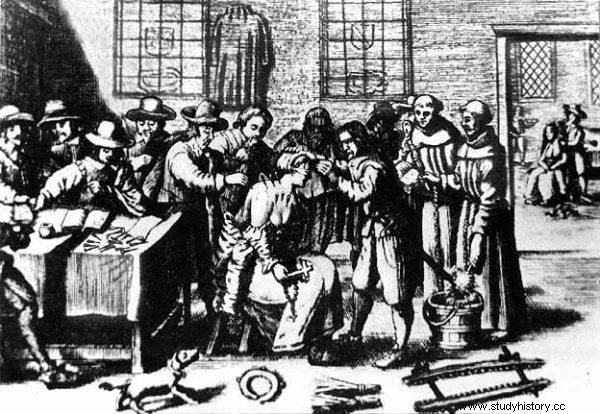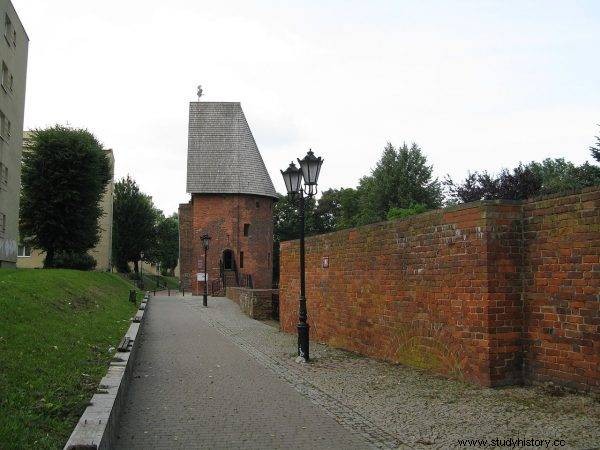Fiery red hair and a fair complexion are not unusual for people today, but in the Middle Ages, the unusual appearance was terrifying. This was the case with Kathrin Zimmermann, later renamed Trina Papisten.
She aroused interest. When she moved to Słupsk and her husband died, she began to avoid people. However, this did not help her avoid the tragedy. Due to the storms destroying everything in their path and the death of the animals, they all turned their eyes to the red-haired woman and decided - a witch. And that was associated with merciless torture and inevitable death.
Life in the 16th and 17th century Europe was not the easiest one, especially for women. It was at this time that the most famous witchcraft trials took place. It was no different in the case of the Słupsk witch Trina Papisten. Brutal torture caused the woman to plead guilty to the charges against her, certainly intending to end her suffering. Although this case does not stand out from other witchcraft trials, it still raises a lot of emotions. Some time ago, the city authorities decided to rehabilitate the woman, thus recalling her tragic history. What was the trial and why was Trina Papisten sentenced?
In pursuit of happiness
Katarzyna (German Kathrin) Zimmermann, because her real name was Trina Papisten, was born in Brilon in Westphalia. She was distinguished by her appearance since she was a child. The woman had fiery red hair and a very fair complexion. Her distinctive beauty attracted the attention of men. She married a blacksmith, Martin Nipkow, with whom she moved to the village of Postomino. The woman dealt with herbalism and the house . The couple decided to move to Słupsk, which was then called Stolp. The city was within the borders of Brandenburg, which was in a personal union with Prussia.
After the Reformation initiated by Martin Luther, the majority of Słupsk society professed Lutheranism. Katarzyna and her husband were Catholics. Stolp, experiencing the Thirty Years' War, was a city in crisis. The situation was not facilitated by epidemics or weather anomalies that recur from time to time, affecting the crop failure.

Life in the 16th and 17th century Europe was not the easiest one, especially for women. It was at this time that the most famous witchcraft trials took place
The couple's happiness in their new place did not last long, as Martin died shortly after moving to the city. From then on, the woman avoided contact with her neighbors. She was involved in herbal medicine and herbal medicine, which she probably earned a living . However, some time later she remarried - to Andreas Zimmermann, a butcher from Słupsk. Happiness smiled at Katarzyna again, but not for long.
Kaśka the Catholic
Once upon a time, Słupsk was hit by a violent storm combined with a hailstorm. The hail destroyed the crops in the fields as well as the fruit growing on the trees. Some time later, a plague of caterpillars was announced in the city. It has been speculated that all these misfortunes are caused by witchcraft or devilish forces. To make matters worse, animals, mainly pigs, died in unexplained circumstances in the vicinity of the Zimmermanns. The rumors spread very quickly to the most characteristic person in the area, i.e. the red-haired Katarzyna . Her specific beauty and the fact that she avoided close contact with people could have influenced speculations about her. All abnormal behavior, beauty and sexuality, as well as a strong character in women, contributed to the creation of this type of accusation. The society quickly recognized these rumors as the truth and avoided contact with the "witch" neighbor. Perhaps the behavior of her neighbors did not raise any objections to her, considering her general distancing.
On May 4, 1701, the pharmacist Ziencker, who had a letter accusing Katarzyna Zimmermann, came to the Słupsk town hall. In addition, he gave the example of two other witches from the village of Łosino, who were supposed to point to her during the torture. P probably the pharmacist wanted to get rid of the competition in this way, because many people used the woman's knowledge in the field of herbal medicine, thus resigning from the pharmacy's services . It was a very common practice. In one of the texts by Aleksandra Zaprutko-Janicka on the pages of the Wielka Historia portal we can read:
"The witchcraft accusation was an ideal solution to problems and conflicts. Husbands got rid of unwanted wives in this way, neighbors took over farms, businessmen dealt with their competition or simply took revenge. Above all, however:women were fought. Especially those dealing with medicine. "
When the couple realized this dangerous situation, they tried to leave the city and go to Gdańsk. Their idea was blocked by the authorities, which demanded a high payment in the event of leaving Słupsk. Soon after, an executioner came to the Zimmermann home to arrest Katarzyna. Despite the protests, the woman ended up in the Witches' Tower. The building, whose hallmark is the witch on a broomstick on the roof, has survived to this day.

Despite the protests, the woman ended up in the Witches' Tower
Despite her husband's efforts to buy out his wife, charges were brought against her. The indictment, formulated in paragraphs 68, accused the woman of selling her soul to the devil. She was also supposed to engage in sexual practices with Satan, as evidenced by the birthmark on her buttock. In addition, she was responsible for the weather anomalies that led to the destruction of the crops, as well as the swine fever she cast a spell on. After the initial questioning, Katarzyna did not plead guilty.
A letter was then sent to the Law Faculty of the University of Rostock, which on July 27, 1701 allowed torture against the accused . The inhabitants of Słupsk, who were keenly interested in the course of this case, mockingly called Katarzyna Trina Papisten, that is, "Kaśka Katoliczka". The nickname comes from the diminutive form of her name (Kathrin) and refers to her religion. Protestants called all Catholics papists, which of course was negative and was tantamount to supporting the pope.
Hexenprozess - the witch's trial
There were many instruments for torture in the Witches' Tower. The then inhabitants of Słupsk were reluctant to stroll along the Słupia River, in the vicinity of the tower. They were probably afraid of some charm or were scared off by shrill shouts from inside the building. Trina, reaching the tower, knew perfectly well what practices were followed there. Nevertheless, at the next interrogation, she did not plead guilty. At that time, it was decided to apply a series of tortures to her. After being crammed into the stocks, her arms and legs were broken and a number of other sophisticated methods were used. However, it did not have the desired effect . The battered woman was thrown back into the dungeon. A few days later she was caught attempting suicide.
Her head was banging against the wall. In this situation, she again ended up in the torture chamber for another series of tortures. This time the executioners poured hot lead on her skin and hammered splinters under her nails. Faced with such unimaginable pain, exhausted and crippled, Trina confessed to most of the alleged acts. In this situation, the judge who was present at the torture asked Trina questions and wrote down her answers. During this interrogation, she was said to testify that she had been in contact with two other witches while she was still living with her first husband in Postomin . However, she later canceled it.

After being chained in stocks, her arms and legs were broken, and a number of other sophisticated methods were used. However, it did not have the desired effect.
On August 30, 1701, Trina Papisten was put on trial. After reading the indictment and the testimony obtained during the torture, the accused was given the floor. Catherine's awareness of her - already a foregone conclusion - fate made her ask for an imminent death by being beheaded with a sword. However, the court refused the request and sentenced Trina Papisten to death by burning at the stake. The sentence was carried out near the Witches' Tower, the accused was transported in a ladder cart to the place of execution. After the court verdict was read and a routine public condemnation was carried out, fire was set on the stake. Katarzyna Zimmermann, known as "Kaśka Katoliczka", is considered the last woman to be condemned for witchcraft in Słupsk.
